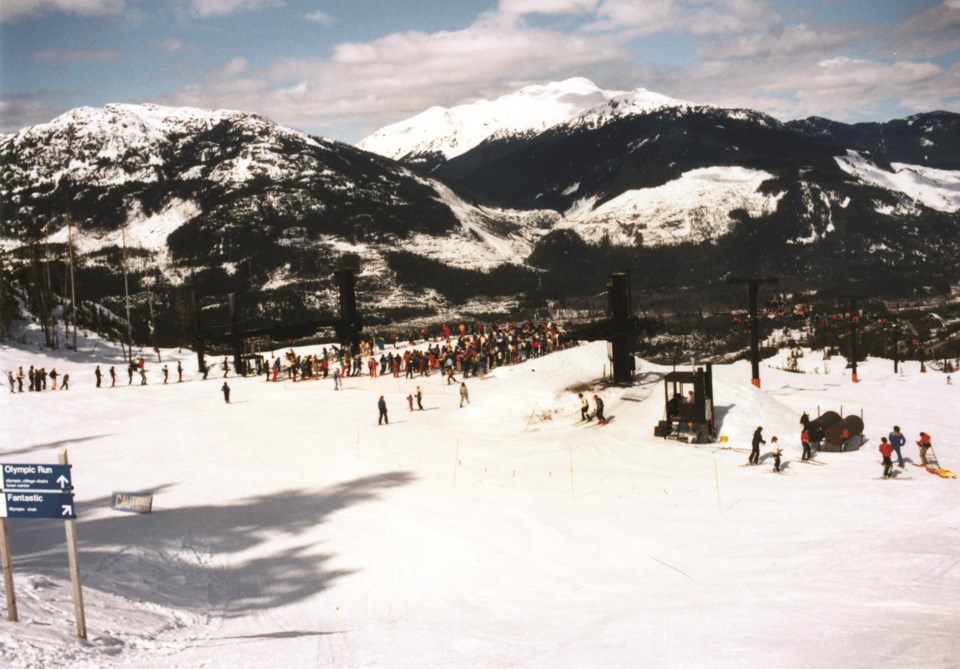Since the Garibaldi Olympic Development Association (GODA) first dreamed of hosting the Olympics on Whistler Mountain, there have been a lot of plans for developments in the Whistler area, both big and small.
Some, such as building lifts or creating Whistler Village, have been fulfilled, but there are many others that never came to fruition. Most of these, including Norm Patterson’s “Whistler Junction” around Green Lake, GODA’s various early plans for an Olympic village, and Ben Wosk’s proposed $10-million development at the Gondola base, never progressed beyond concept drawings and scale models. Also on the long list of developments that did not come to fruition are plans the Whistler Mountain Ski Corporation (WMSC) had for Olympic Meadows on Whistler Mountain.
In January 1987, WMSC ran a nationwide ad campaign courting developers. The ad included drawings of Whistler Mountain’s existing lifts, plans for mountain and real estate development, and an architect’s drawing of a large hotel at the gondola base. When WMSC unveiled its development plans to the Resort Municipality of Whistler (RMOW) in February, however, the plans centred not on the gondola base but on Olympic Meadows, an area at the base of the Black Chair (today the top of the Olympic Chair).
Early ideas for Olympic Meadows included moving the office and maintenance facilities up from the gondola base and building hotel rooms and parking, serviced by a 4.1-kilometre road which could eventually be lined with residential development. There were a few different options for hotel developments on the site, ranging from a 340-room “lodge-style hotel” with 500 day parking stalls to two terraced hotel blocks up to nine stories high with a total of 1,200 rooms.
Over the next months, WMSC’s plans for Olympic Meadows were refined and WMSC president Lorne Borgal brought in landscape architect Eldon Beck (which is why he was in town to talk with Kevin Murphy about Village North—see Pique, Aug. 25, “Expanding the village: Part 2”). By the fall, development plans were referred to as “Whistler 1000” and “Whistler 900.” Whistler 1000 featured lodges, townhouses, some commercial services, tennis courts, and 1,000 stalls of day skier parking at the top of the Village Chair (today’s Olympic Station), which, at the time, was set to be replaced by a high-speed gondola in the next couple of years. Whistler 900 would be located nearby above Brio with future plans for a chairlift from Whistler 900 to the base of the Orange Chair. Both Whistler 1000 and 900 would be accessed by a winding road off of Panorama Ridge.
WMSC’s plans depended on development rights recognized by the ski area agreement with the province but not included in the RMOW’s Official Community Plan (OCP). The RMOW was in the process of reviewing the OCP, but timing was tight. WMSC needed the development rights in place before placing the order for new lifts and ski-related development, which needed to go in by February 1988. The earliest date for possible amendments to the OCP was January. At one time, there was even talk of Whistler Mountain trying to legally separate from the RMOW, though it was not thought likely.
While WMSC was developing its plans for Olympic Meadows and waiting to hear about amendments to the OCP, its competition Intrawest was also presenting big plans for the Benchlands and Blackcomb Mountain.
WMSC came close to getting the amendments it needed in January 1988, when council began drafting bylaws to amend the OCP, but community concerns about the scale and elevation of the proposed development, as well as the pace of development in Whistler more broadly, meant these amendments were not ultimately approved and the WMSC plans were stalled.
Blackcomb Mountain and the Benchlands experienced massive development that year, but Whistler 1000 and Whistler 900 never did break ground. However, at least one of the WMSC’s plans did materialize: the Village Chair and Black Chair were both replaced in 1988 by the Village Express gondola.





